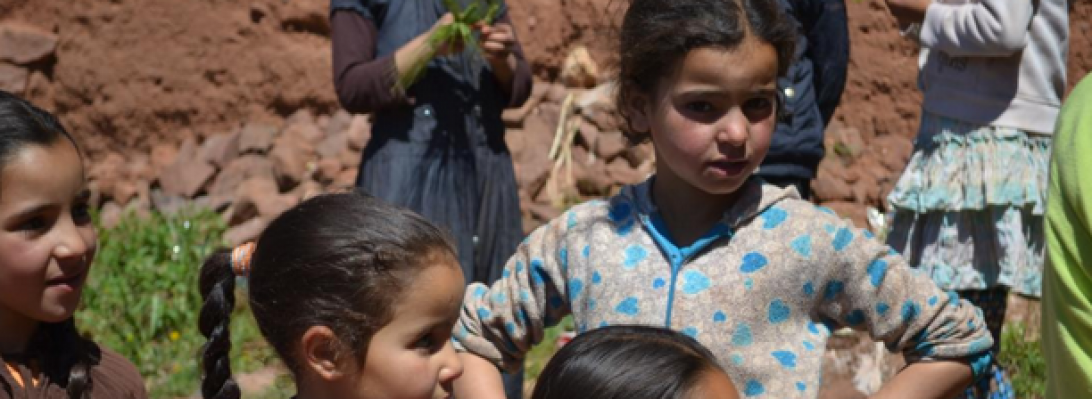We exited Fes Thursday morning about ten o’clock for a two day sojourn in the Middle Atlas mountains. Our plans included a visit and noon meal at The Haven orphanage outside the small town of Azrou, spending the night at the home of our friends and former colleagues at Al Akhawayn University in Ifrane, and having lunch on Friday at the parents of a lottery visa winner about three years ago, whose integration into life in the U.S. we had helped facilitate. She eventually moved to Cincinnati, and we attended her wedding there in January of 2011.
The easterly drive from Fes through the village of Immouzer about 25 kilometers away, and then another 40 kilometers to Ifrane, located at an elevation of approximately 1600 meters, is one of the most beautiful drives in the country. Expansive panoramas of practically every shade of green in the spectrum, the result of one of the wettest Moroccan winters in 40 years, provided a stunning backdrop for scenes of contemporary rural life that stand in stark contrast to life in the U.S. Many of the views were powerful reminders that life is awfully difficult compared to that with which we are familiar.
When we departed, the sun was shining and the temperature approached 60 degrees. Before we had traveled 10 miles, an abrupt chance began to occur, and soon we were in the middle of a serious rainstorm with strong winds, and the visibility that had earlier provided the scenic views, were reduced significantly. Nevertheless, as we progressed along the highway, we passed a number of shepherds watching 30 to 40 sheep, and herders with four to ten cows, hunched over in protective clothing providing some protection against the elements, but still facing what had to be the remainder of a miserable work day. What kind of hope could one offer: “Hang on, your torture will be over in seven or eight hours.” Carrying a staff and keeping animals off the highway in 45 degree weather in a driving rain is not a job description that appeals to me. The scripture that says, “the shepherd cares for his sheep” certainly takes on a whole new meaning.
Passing a seven or eight mile stretch of scrub oak tree forests, we noticed roadside vendors of wild honey, containers such as cooking oil empties or one liter mineral water bottles containing the bronze liquid. The product is displayed on overturned boxes or piles of rocks so that passengers in cars can get a better view. The proprietors have no better protection from the inclement weather than the shepherds and the few vehicles that actually stop must do little to relieve the boredom of such an enterprise. Some of the actual locations are so remote that it is easy to imagine that one might be able to obtain a side of locusts along with the honey.
I noticed that compared to what I had once observed decades ago, the development of the fruit and nut industry has been impressive Practically all of the suitable plots of arable land that is flat enough has been leveraged for the planting of trees to produce apples, peaches, pears, plums, cherries, and apricots. Entire fields of snow white blossoms foretell the coming harvest of tons of almonds, a pervasive ingredient in the preparation of many different types of tagines. Even small plots of ground near the road, or between farm structures such as barns and sheds, are exploited for the additional fruit that can be produced.
We passed through Ifrane, a town developed in the fifties during the French Protectorate primarily as a mountain resort, and sporting the appearance of a Swiss alpine village with steep red-tile roofs and off-white stucco walls. Azrou is only 10 miles or so from Ifrane, and The Haven is located about two miles outside the town limits toward Ifrane. Along that road is one of the most well-known overlooks in the entire country. Though we could see nothing but clouds on Thursday, we really didn’t need additional photographs from that location, since we have taken pictures there in every decade since the seventies.
We spent a couple of hours at The Haven; it’s a home for children but not technically an orphanage since a number of the children who live there have parents who are still alive. However, they have either been abandoned, or voluntarily handed over to the folks who agree to raise the children. At the moment 21 children are taken care of in three families. The couple who have come out of “retirement” to manage the home first came to Morocco in the mid-fifties and has been involved in that endeavor since that time. The depth of their commitment and faith never fails to provide us with a special dose of inspiration.
Sharing a meal with all the children and staff, and then a time of conversation over mint tea and pastries made it a very special day. Though we had been reminded of our good fortune in the work we had been able to engage in over the years, we also saw that following paths different from our own can provide a profound sense of fulfillment. In the meanwhile, we observed a number of children provided with their own good fortune by being raised in an environment of love and acceptance and being provided hope and a future.
Fred
